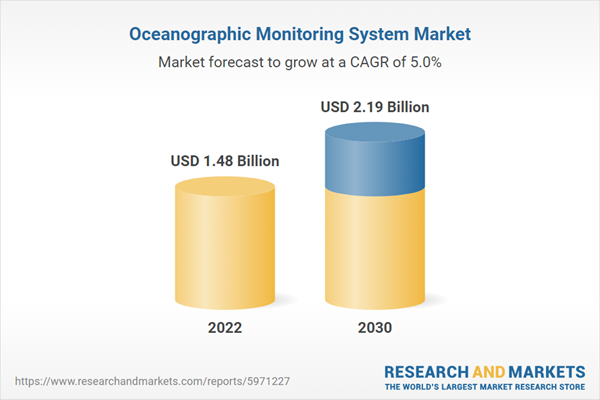Autonomous Underwater Vehicles (AUVs) are unmanned submersibles integrated with advanced technologies that enable them to cruise the ocean automatically without the need for direct human involvement. These cutting-edge devices are loaded with sensors, cameras, and data collection equipment, offering scientists unprecedented access to the ocean's depths. AUVs' applications include traditional research vessels as well as making maritime exploration more efficient and cost-effective. AUVs lower the risk of diver-related safety hazards during deep-sea research and data collecting by eliminating the necessity for human presence underwater.
Moreover, Unmanned Surface Vehicles (USVs) are used for a wide range of applications in sheltered waters, coastal areas, and offshore waters. Technological developments such as AUV and USV have improved the capabilities of oceanographic services, including the efficiency and precision of data collecting. These vehicles, along with complex sensors, can collect high-resolution information on a range of oceanographic characteristics, including wave height, salinity, temperature, and currents. When considering traditional methods such as ship-based sampling, the data collected through these vehicles is considerably more reliable and accurate. Thus, the incorporation of autonomous underwater vehicles (AUVs) and unmanned surface vehicles (USVs) for collecting oceanographic data is expected to fuel the oceanographic monitoring system market growth in the coming years.
There are several uses for remote sensing in the fields of physical, biological, coastal, and satellite oceanography. Remote sensing can be used in oceanographic research to gather data on marine and coastal phenomena, monitor them, and analyze them using airborne and spaceborne sensors. Compared to traditional methods, remote sensing has numerous benefits, including area averaging, repeated observations, and synoptic coverage. Ocean weather and climate analysis, primary productivity measurement, water quality monitoring, potential fishing zone detection, marine life assessment, marine pollution monitoring, near-shore bathymetry and mapping determination, ocean current and wave sensing, human impacts on marine and coastal life, etc., are the main applications of remote sensing technology. Satellites monitor changes in the ocean continuously which help scientists to study the latest trends. Understanding long-term processes such as climate change and the way they affect the oceans depends on the study analysis. Large-scale ocean regions can be imaged by satellites, making it impossible to provide a complete picture of different phenomena such as sea surface temperature, currents, and sea ice extent using conventional ship-based techniques. Thus, the use of remote sensing technologies and satellite imaging set future trends for the oceanographic monitoring system market growth.
By type, the market is segmented into sensors, underwater communication system, buoys observation monitoring system. The sensor segment held substantial oceanographic monitoring system market share in 2022. By application the market is segmented into onshore and offshore. The onshore segment held major oceanographic monitoring system market share in 2022. Further, the geographic scope of the oceanographic monitoring system market report focuses covers North America (the US, Canada, and Mexico), Europe (Spain, the UK, Germany, France, Italy, and the Rest of Europe), Asia Pacific (South Korea, China, India, Japan, Australia, and the Rest of Asia Pacific), Middle East & Africa (South Africa, Saudi Arabia, the UAE, and the Rest of Middle East & Africa), and South & Central America (Brazil, Argentina, and the Rest of South & Central America).
GOST Global, Hitachi Zosen Corporation, Ocean Scientific International Ltd, Sonardyne, Seatools B.V., Xylem, Trelleborg Marine and Infrastructure, Valeport Ltd, SERCEL, MOBILIS, AXYS Technologies Inc., Smart Buoy Co., TechWorks Marine, Sea-Bird Scientific, and Neil Brown Ocean Sensors, Inc. are among the prominent players profiled in the oceanographic monitoring system market report. The oceanographic monitoring system market forecast is estimated on the basis of various secondary and primary research findings such as key company publications, association data, and databases.
The overall oceanographic monitoring system market size has been derived using both primary and secondary sources. Exhaustive secondary research has been conducted using internal and external sources to obtain qualitative and quantitative information related to the oceanographic monitoring system market analysis. The process also helps obtain an overview and forecast of the market with respect to all the market segments. Also, multiple primary interviews have been conducted with industry participants to validate the data and gain analytical insights. This process includes industry experts such as VPs, business development managers, market intelligence managers, and national sales managers, along with external consultants such as valuation experts, research analysts, and key opinion leaders, specializing in the market.
Table of Contents
Companies Mentioned
- GOST Global
- Hitachi Zosen Corporation
- Ocean Scientific International Ltd
- Sonardyne
- Seatools B.V.
- Xylem
- Trelleborg Marine and Infrastructure
- Valeport Ltd
- SERCEL
- MOBILIS
- AXYS Technologies Inc.
- Sea6Energy
- Smart Buoy Co.
- TechWorks Marine
- Sea-Bird Scientific
- Neil Brown Ocean Sensors, Inc.
Table Information
| Report Attribute | Details |
|---|---|
| No. of Pages | 161 |
| Published | April 2024 |
| Forecast Period | 2022 - 2030 |
| Estimated Market Value ( USD | $ 1.48 Billion |
| Forecasted Market Value ( USD | $ 2.19 Billion |
| Compound Annual Growth Rate | 5.0% |
| Regions Covered | Global |
| No. of Companies Mentioned | 16 |









